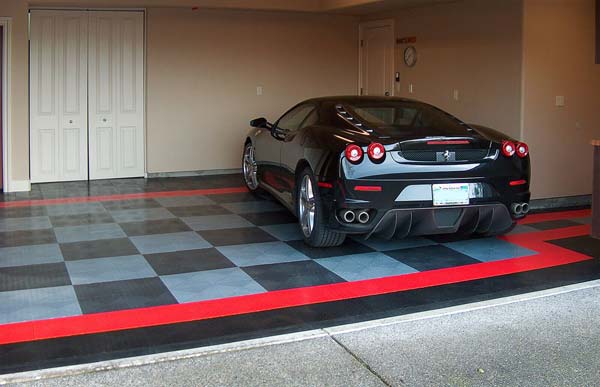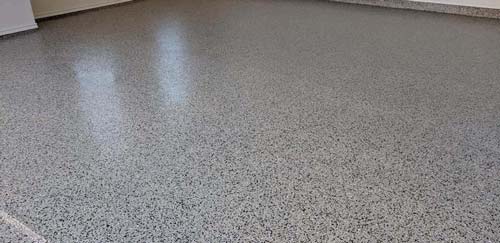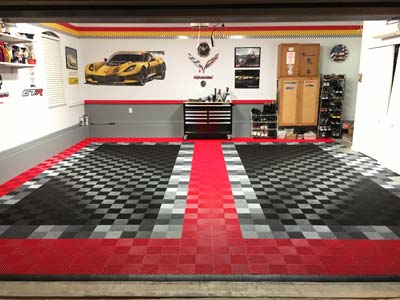When we enter a new indoor space, its flooring sets up the tone for the entire experience. A muted motif lets us know that the occupants of this place prefer being sophisticated, while a more vibrant design will tell us how adventurous the owners might be.
Especially when it comes to commercial garage space, the flooring style lets the clients know what to expect. If you are planning to renovate such a space, get to know about the two most popular options, RaceDeck vs epoxy flooring so that you don’t fall into a dilemma.
What is RaceDeck Flooring?
If you love colors, vibrancy, and patterns, RaceDeck flooring can satisfy your vision for your garage design.
It allows you to take a detour from the usual monotonous floors and experiment with more artistic choices to make an attractive canvas on which the cars will be placed.

The core concept of RaceDeck flooring is related to modular tiles. Since these tiles don’t have to conform to the usual sizes or shapes, you can find more room for creativity while working with them.
That is why car dealerships usually choose this flooring in a checkerboard pattern to showcase their gorgeous vehicles.
Advantages of RaceDeck Flooring
Ease of Installation And Maintenance
Compared to the usual flooring, you will find RaceDeck much easier to install and maintain because of its modular tiles.
You don’t have to look for specific tools or try to hire a professional to put them in place. Just clean up the floor and use a saw or a razor knife to cut the tiles according to your selected pattern.
It will also be a much less messy situation since it doesn’t involve glue, chemicals or fumes.
The biggest advantage of choosing this flooring is how easily you can just replace a faulty tile, without disturbing the other tiles around it. All you have to do is lift and remove that damaged tile with a putty knife.
Versatile Patterns and Customized Palettes
Many people find floors boring because most of them have the same appearance. Even in the case of garage flooring, the traditional style or pattern doesn’t seem to spark an interest.
That is why, flooring companies tend to create their own pattern and implement that style for all clients.
RaceDeck however manages to break this stereotype and offers multiple patterns or styles to its customers.
Their collection includes six flooring styles, as well as 14 standard colors which can be either striking contrasts or monochromatic hues.
If you want, you can also customize your own color palette to make your garage space even more unique. Their modular tile approach makes such flexibility possible in floor designing.
Good for Outdoor Use
These tiles are manufactured to withstand pretty extreme temperatures. To be more specific, they will be fine as long as the surrounding temperature is between 0 and 120 degrees Fahrenheit. So you can rest assured that your garage space is not suffering because of colder or hotter days.
Such endurance also makes RaceDeck a good choice for using outdoors. If you want to have colorful flooring outside for any personal or professional project, it can make that possible.
Disadvantages of RaceDeck Flooring
White Tiles Get Dirty Frequently
While RaceDeck tiles look great and can handle very heavy weights, the white ones tend to get dirty easily and frequently.
If you use them in a regular garage space where the vehicles need to be cleaned, repaired, and maintained, the resulting debris will get accumulated on the tiles. These dirt particles are not that visible in darker colors like red and green, but they do become quite conspicuous on a white tile.
Low Durability
Unfortunately, even though it can withstand quite extreme temperatures, not all versions of RaceDeck turn are as durable as other flooring options in the market. Since they are plastic, they are more susceptible to usual physical deteriorations like cracks and become quite damaged within 3-5 years.
What is Epoxy Flooring?
Epoxy is primarily a coating that differs from the usual floor paints in many ways. First of all, its chemical composition includes polymer resins which are then combined with hardeners to achieve the required bond. This results in a stiff plastic material that can then be used for epoxy flooring.
For the flooring, multiple layers of epoxy are applied where each layer needs to be at least 2mm thick. Any less than that will be considered as only an epoxy coating, not flooring.
Advantages of Epoxy Flooring

Impressive Durability
Even though it is technically plastic, epoxy flooring can still provide high durability. Similar to RaceDeck, it can also withstand extreme temperatures.
Moreover, it shows great resilience to stains, scratches, chemicals, and oils. Such high resistance to marks makes it an ideal choice for garage floors with high foot or machine traffic.
Sanitary And Easy Cleaning
Since it is poured, epoxy flooring doesn’t have joints, ridges or seams where both visible and invisible dirt particles usually accumulate. As a result, its default design makes it a much more sanitary option to include in your space. Additionally, its smooth surface makes epoxy floors much easier to clean.
Waterproof
While many flooring options tend to lose their original charm due to water damage, epoxy flooring manages to sustain such danger with its waterproof composition. Coming in contact with water does not make it warped or blemished, and you can enjoy the intact surface for a longer time.
Disadvantages of Epoxy Flooring
Complex Repairs
If one part of the floor gets damaged for some reason, you might need to recoat the entire floor to repair it. Additionally, removing the epoxy coating from a concrete floor is a long, tiresome and costly process. You will definitely need to hire a professional in order to protect the concrete layer underneath.
Toxic Fumes
A major issue with the complicated and time-consuming process of installing epoxy flooring is the emission of strong toxic fumes.
That is why you will encounter a sharp ammonia-like odor when the professionals will start applying it. These toxic fumes can harm people within that area through inflammation and breathing issues, in case they inhale it.
Related: Guide To Buy Best Epoxy For Aluminum Bonds & Repairs
Comparing Epoxy Vs RaceDeck

1. Applications
Being manufactured for harsh environments, RaceDeck is primarily used for garage flooring.
On the other hand, epoxy has a huge range of applications due to its wide variety. For instance, the self-leveling and mortar types of epoxy flooring can be used at commercial garages, showrooms, warehouses, kitchens, and more. In contrast, the quartz type is more suitable for offices, schools, and cafeterias.
However, in the case of outdoor use, RaceDeck is more favorable than epoxy since the latter gets damaged under long exposure to UV rays. Epoxy tends to fall victim to cracking, chalking, and yellowing because of it. As a result, RaceDeck – which can withstand temperatures up to 120°F – is the better option for outdoor flooring.
2. Durability
Both RaceDeck and epoxy can last for up to 10 years with proper maintenance. At the very least, they should be fine for a couple of years.
After that, they will start showing signs of wear and tear according to the traffic they have to endure regularly. Although, when compared closely, epoxy seems to wear away faster than Racedeck.
3. Ease of Installation
Since RaceDeck is based on modular flooring, its installation process is much easier and can be completed by the user. Epoxy flooring is quite difficult and time-consuming since there are a lot of factors you have to keep in mind for it.
In addition to a concrete floor free from debris, it also needs to be free of oil and grease. Moreover, the humidity levels need to be low so that moisture doesn’t get trapped underneath.
4. Appearance
RaceDeck floors are much more vibrant, experimental, and stylish compared to epoxy floors. They can arrange the tiles in innovative ways and customize the color combinations to create a striking pattern on the floor.
Epoxy doesn’t offer that much leeway for creativity and stays limited to a number of standard designs.
5. Cleaning
Epoxy floors are easier to clean than RaceDeck since their surfaces don’t have ridges or joints where dust can pile up over time. Its smooth and waterproof surface can be cleaned off with much less effort than the modular tiles. In fact, RaceDeck tends to get dirty a lot more frequently than epoxy.
6. Repairing
If any part of your garage space flooring has become damaged, it will take less money, time, and effort to repair the RaceDeck tiles than epoxy. All you have to do in the former case is remove that particular damaged tile and replace it with a new tile.
Since epoxy flooring involves pouring, repairing its portion requires recoating the entire surface which definitely ends up being very expensive, time-consuming, and tiresome.
Bottom Line: Which One is For You?
As you can see, both Epoxy and RaceDeck have a lot to offer in terms of both style and substance. However, when you compare RaceDeck vs Epoxy that closely, the former turns out to be the winner by a very narrow margin.
RaceDeck provides easier installation, easier repair, higher durability, and outdoor usage. Besides, you can experiment more with its large palette of colors and styles to get a breathtaking space for attracting new clients or customers.

